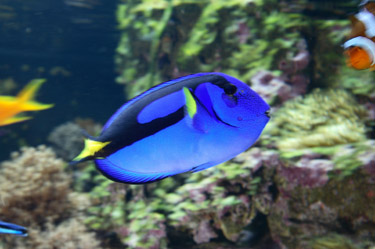Fish: Health and Disease
Healthy Fish
The secret to success in keeping ornamental fish is water quality. Fish live in permanent contact with their aqueous environment and are totally dependent upon it.
Always remember that fish live in their own toilet! They excrete into the water, copiously and continuously. It is not the solids (feces) that present the major problem, but the fish's equivalent of our urine. They excrete ammonia, which is soluble and invisible, but deadly poisonous. If the aquarium (or pond) is too crowded or neglected, the ammonia builds up and poisons the fish. It irritates the gills and extra mucus forms, which reduces the oxygen uptake. The fish then gasp at the surface for air. Next, the ammonia will burn the skin and the fish start to scratch (called flashing). The fins are attacked next, leading to fin rot. At only a few parts per million, ammonia will actually kill the fish.
Owners see these symptoms and may buy an air pump, thinking that the oxygen level is low even though it isn't, and then add anti-parasite chemicals which add to the fish's irritation. Finally owners may use antibiotics, which destroy valuable nitrifying bacteria, making the situation worse. All this is unnecessary—all that is needed is to flush that toilet! Regular partial water changes are essential. If you use tap water, add a little dechlorinator, or at least let the water stand for a few hours to let the chlorine evaporate away.
Fish Diseases
Virtually every fish keeper experiences an outbreak of disease in his fish at some point. Many fish disease problems are actually caused by poor water conditions and not by parasites or bacteria. Hence, if a disease outbreak occurs, always first check the nitrite, pH and temperature of the water just in case one or more of these conditions is the cause. Always check the filter. A clogged or poorly working filter can give rise to water pollution, which itself can predispose fish to diseases.

Sometimes, however, the disease is caused by parasites or other disease causing organisms. Such diseases are know as infectious diseases because they potentially are able to spread from one fish to another.
Infectious diseases can be categorised as follows:
Parasitic Diseases
Many of the more common parasitic diseases occur on, or just beneath, the body surface of the fish, such as velvet, whitespot and flukes. Affected fish are often irritated by these skin parasites and respond by repeatedly flicking their fins or scratching their bodies in the rocks. Sometimes the gills are also affected, such that the fish may breathe heavily (fast gill beats) and it may remain near the water surface, enabling its damaged gills to take in more oxygen. Various anti-parasite cures are available from your veterinarian or your aquatic retailer.
Fungal Diseases
These generally affect fish, which are already weakened or stressed, so, always check the water conditions if a fungus outbreak occurs. Also, skin injuries caused by fighting or from rough handling in the net are prone to fungus attack. Fungus manifests as white to grey "cotton wool," like growths on the fish's body or fins. Anti-fungal cures are available from your veterinarian or your aquatic retailer.
Bacterial Diseases
These can manifest as ulcers, reddened lumps, or rotting of the skin or fins. Anti-bacterial remedies are available from the aquarium stores; however, in severe infections, antibiotics may be required, which in many countries are prescribed by your veterinarian.
Viral Diseases
These are probably more common than generally believed. One well-known virus disease is lymphocytis, which appears as small white, grape-like clusters on the fish's body or fins. Fortunately, this infection is rarely fatal. At present, there are no chemical cures for viral infections of fish. The best advice is to keep the affected fish under optimum, stress-free conditions in the hope that its immune system will overcome the virus.
Prevention is Better than Cure!
The seven golden rules for preventing diseases in fish are:
- Buy your fish from a reputable retailer or breeder and never purchase specimens which appear unwell.
- Quarantine new fish for two to four weeks, wherever possible—a small extra aquarium is ideal for this purpose.
- Always pay attention to the water quality in your aquarium and ensure that the water conditions (temperature, pH, etc.) are suitable for the species you keep.
- Never overstock the aquarium.
- Do not purchase fish which are known to fight or bully their tankmates.
- Remove dead or dying fish; otherwise, they may pollute the aquarium, and in some cases, can transmit diseases to other fish which happen to forage over the carcass.
- Always feed a balanced diet of high quality.
[ Search Articles ] [ Article Index ]
